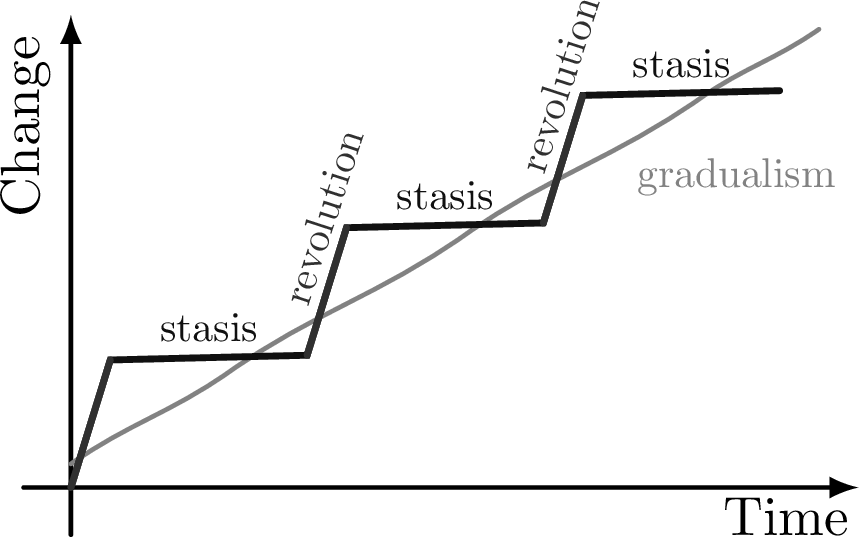Introduction
Punctuated Equilibrium is a powerful mental model that explores the dynamics of change and stability in decision-making processes. Rooted in human psychology, this model recognizes that change often occurs in sudden bursts, known as punctuations, followed by longer periods of relative stability. Understanding Punctuated Equilibrium is crucial for recognizing its prevalence in our daily lives and avoiding the pitfalls of making irrational decisions during times of change.
The Psychology of Punctuated Equilibrium
Punctuated Equilibrium is anchored in human psychology and reflects our inherent desire for stability and resistance to change. It acknowledges that our decision-making processes are influenced by both short-term disruptions and long-term patterns. During periods of stability, we tend to stick to established routines and strategies, while punctuations force us to adapt and make new choices.
Examples of Punctuated Equilibrium
- Personal Life Decisions: Imagine a person who has been in a stable job for several years. They have grown accustomed to their routine and have a sense of security. However, due to a sudden change in the industry or company restructuring, their job becomes uncertain. Faced with this punctuation, they may make hasty decisions out of fear or panic, such as accepting an unsuitable job offer or making impulsive career changes.
- Business Scenarios: In the business world, punctuations can occur through technological advancements, market disruptions, or economic crises. Consider a successful company that has been following a stable business model for years. When faced with a sudden industry disruption or a new competitor entering the market, the company may react hastily and make ill-informed decisions, neglecting careful analysis and long-term planning.
- Public Policy-Making: Punctuated Equilibrium is also relevant in public policy. Major events, such as natural disasters, political shifts, or societal movements, can trigger punctuations. Decision-makers may respond impulsively to these punctuations, hastily enacting policies without considering the long-term consequences or engaging in meaningful public dialogue.
Mental Biases and Underpinnings of Punctuated Equilibrium
Several cognitive biases contribute to the challenges of navigating Punctuated Equilibrium. The “Availability Heuristic” bias, for example, leads individuals to rely on easily accessible information when making decisions. During times of change, recent punctuations or disruptive events become highly salient and may disproportionately influence decision-making, disregarding longer-term patterns or data.
The “Status Quo Bias” is another relevant bias in the context of Punctuated Equilibrium. It refers to our tendency to favor the current state of affairs and resist change. During periods of stability, individuals may develop a strong attachment to existing routines or strategies, making it difficult to adapt to punctuations and embrace new approaches.
Identifying and Overcoming Punctuated Equilibrium
To identify and avoid succumbing to the pitfalls of Punctuated Equilibrium, consider the following strategies:
- Embrace a Growth Mindset: Cultivate a mindset that views change as an opportunity for growth and learning. By adopting a flexible and adaptable attitude, individuals can navigate punctuations with a willingness to explore new possibilities rather than making impulsive decisions driven by fear or resistance.
- Conduct Long-Term Planning: Develop a habit of long-term planning and analysis. During periods of stability, regularly reassess the effectiveness of current strategies, considering potential punctuations and their potential impact. This proactive approach enables individuals to anticipate change and make informed decisions rather than being caught off guard.
- Seek Diverse Perspectives: Engage in active listening and seek out diverse viewpoints, especially during times of change. Encourage open dialogue and consider a range of perspectives before making decisions. This helps to counteract biases and ensures a more comprehensive understanding of the situation at hand.
Conclusion
Punctuated Equilibrium offers valuable insights into decision-making during times of change. By recognizing the prevalence of this mental model in our lives, understanding the associated biases, and adopting strategies to mitigate its effects, we can make more informed and objective decisions. Being aware of the potential pitfalls of Punctuated Equilibrium empowers us to navigate punctuations with composure, adaptability, and a long-term perspective, leading to better outcomes and personal growth.
